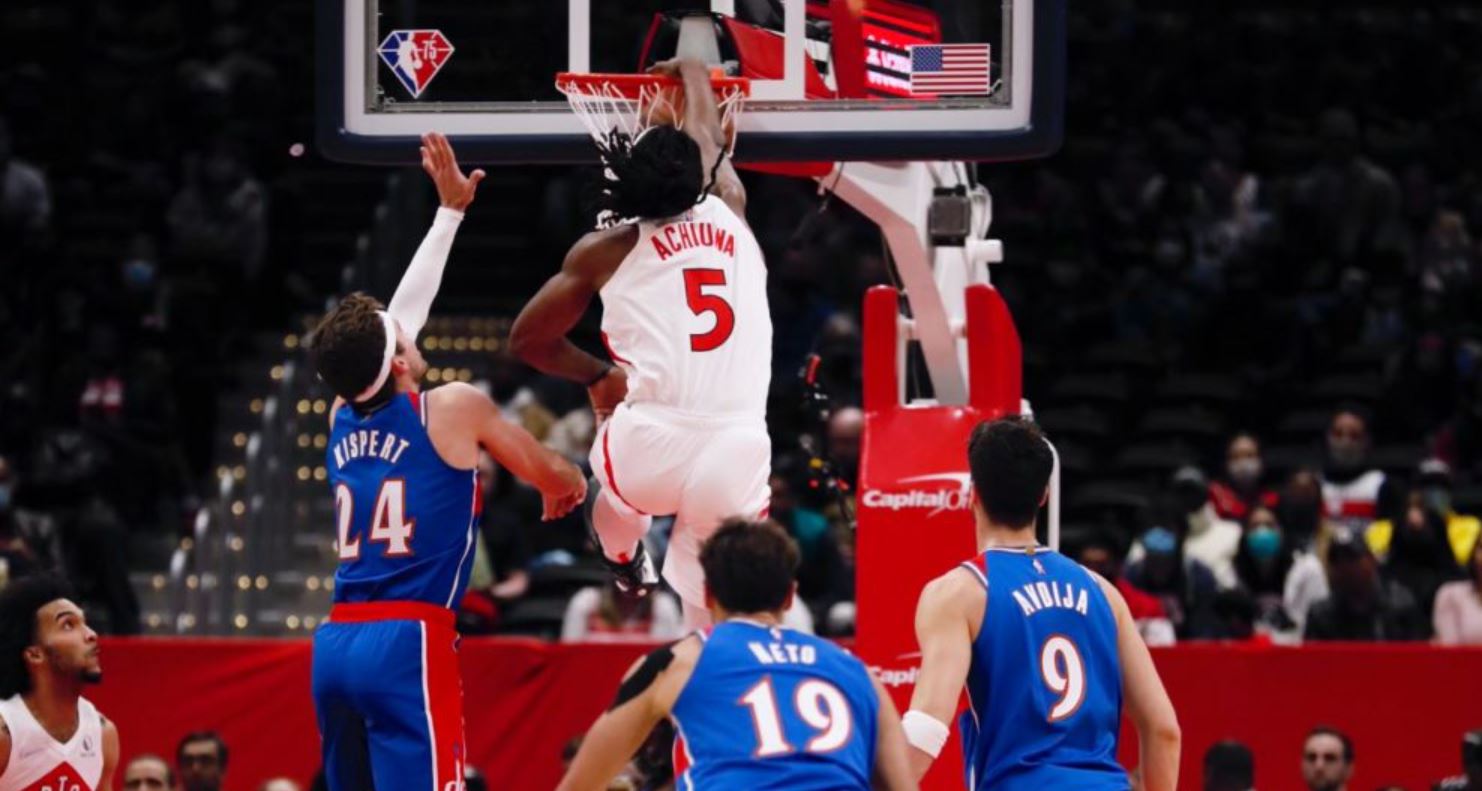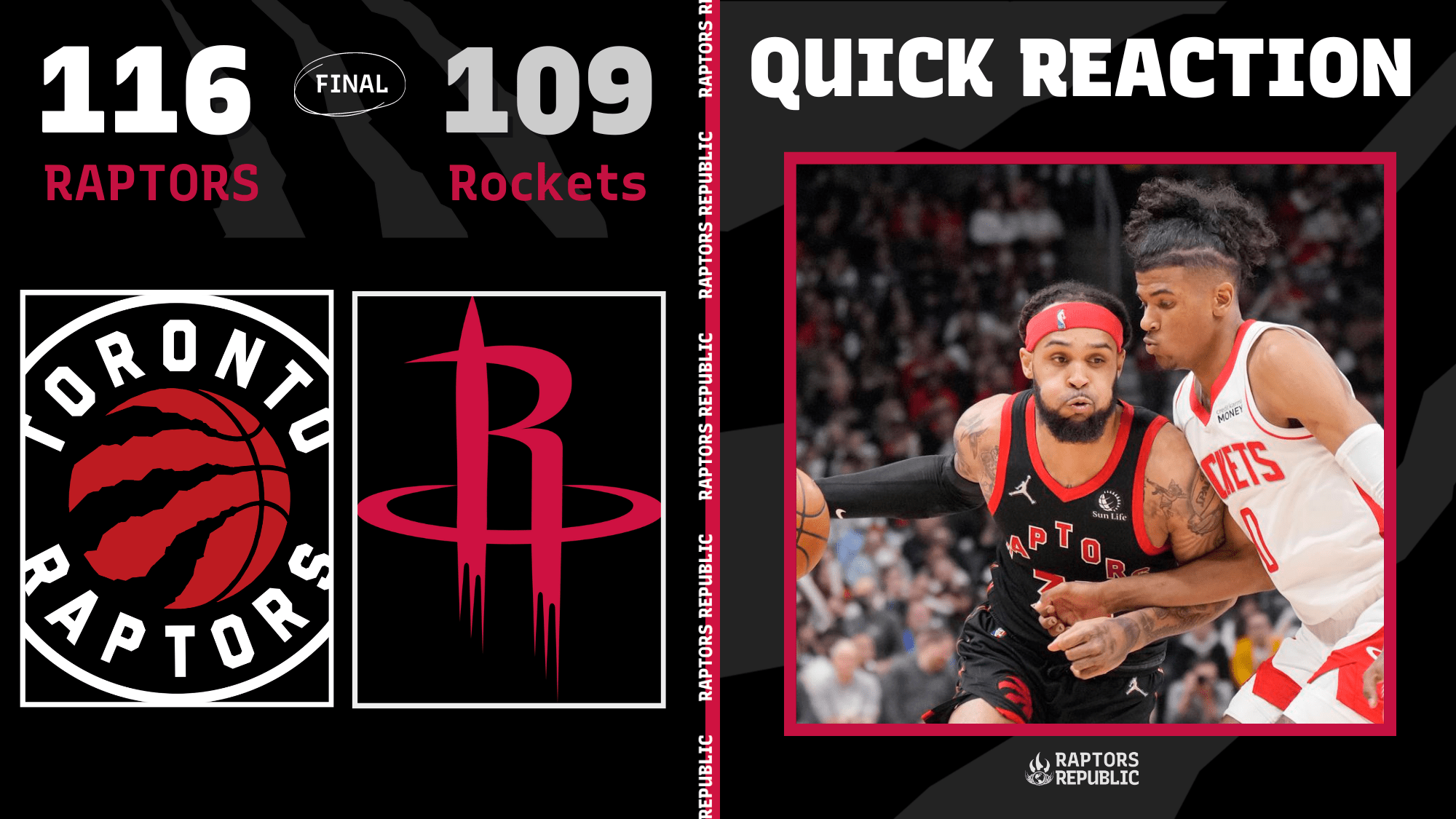The following is a guest post by Ali Iqbal.
Just three seasons ago, the Toronto Raptors’ ‘bench mob’ took over the culture and earned a cult-like status. Players like Jacob Poeltl, Fred VanVleet, Delon Wright, and Pascal Siakam formed this bench group that would light up scoreboards and clamp up offenses, allowing the starters to gain valuable rest. The infamous bench mob was partially wiped away during the 2018-2019 season championship season; however, the remnant of the mob is still present (especially with VanVleet and Siakam now full-time starters). The bench depth for the squad has failed to reach the level of the mob over recent years, which has resulted in increased game time (and dependence) on the starters. For a Raptors team with playoff ambitions, depth is gold. The early signs of this year’s squad has signaled a subtle rejuvenation of the bench unit, and beneath most people’s noses, the Raptors have built a stronger bench unit. However, can the team’s bench players be considered a form of bench mob 2.0? Or is the bench unit something else, perhaps a strong complementary piece?
Let’s start by understanding what entails a bench mob. During the 2017-2018 run, what made the mob special was the fact that they often played together, as a five-man unit. The 2017-2018 squad had a strong 20 percent of possessions with no starters on the court, the largest share in the league. This is significant, as starters were able to rest, while the bench could control the game without dependency on any member of the starting five. Looking at the same metric for this 2022-2023 season, the percentage of possessions with no starters is 4 percent. The entire bench is not trusted to play by itself. Why a dependence on starters? The bench guys discussed in this piece lack consistent spacing, which is a hindrance in the 3-point era. The bench also lacks a classic ball-distributing point guard, and while the team prides itself on positionless basketball, the lack of a distributing-spacing point guard on the bench puts reliance on players like VanVleet and Barnes (note how Vanvleet is averaging the fifth- most minutes per game in the NBA). The current bench unit for the Raptors does not fit the bench mob archetype. Although the team may not be like the traditional bench mob, what is apparent is that the bench depth is deeper than what is on the surface. Bench players can contribute — when propped up by a starter or two. Perhaps, the bench can be labelled as a hybrid, complementary group of sidekicks. Indeed, the Raptors have the best net rating in the league with one bench player on the court and the fourth-best with three. The Raptors don’t use their bench the same as they did in 2017-18, but it is effective in its new role.
For sake of argument, let’s stick with a fixed starting lineup of Fred VanVleet, Gary Trent Jr., O.G. Anunoby, Scottie Barnes, and Pascal Siakam (when he returns from injury). There are five Raptor players that shape the second unit: Precious Achiuwa, Chris Boucher, Christian Koloko, Otto Porter Jr., and Thaddeus Young. While these five have not played together as a unit this season, their individual attributes align well. They are giants, with defensive and rebounding capability. However, most interestingly, there is an offensive spark that each of these players can contribute, on the perimeter and in the paint. Let’s look at each player individually.
Starting with Precious Achuiwa, his breakout exploded post All-Star break last year, where his perimeter presence grew, while his rim-running and defensive versatility continued to take shape. Since then, Achuiwa has continued to show positive glimpses this season, averaging 9.1 points and 7.2 rebounds per game. His 3-point shooting has looked shaky, shooting 19.2 percent compared to an impressive 35.9 percent last year, but this can hopefully be attributed to the small sample size of the season. The advanced stats show his impact in better perspective. He has raised his total rebound percentage and usage percentage (at 20.5 percent), with interesting spikes in assist percentage and free throw percentage. Worth mentioning: high usage with low efficiency is a warning sign, hence improved shooting is a priority for Precious to maximize his usage. If his shooting does not improve, then his high usage rate is detrimental. It is clear that Achuiwa is looking to diversify his role this year. In many cases, he has brought the ball up the floor, and he is not afraid to drive, as he has the highest drive rate of all second-unit players and shoots efficiently off drives. With his passing and free throw quantity improving, his contribution to offensive production becomes much richer, and if he figures out his 3-point shooting again, Achuiwa can get more league-wide notice of being one of the better bench players.
Chris Boucher started the season out with injury; however since his return to the lineup, he has taken no time to settle in. In signature fashion, Boucher has continued to lead with his three ball, shooting 45.8 percent on 3.4 looks per game, with a consistent 5 rebounds per game. His 3-point percentage is not sustainable and will likely fall; however his confidence from the arc has formed his identity for the team, and he keeps defenders on edge. Even if he doesn’t keep making them at such a clip, he will draw defenders out beyond the arc and add much-needed spacing to his teammates. For a bench unit that lacks conventional spacing, Boucher is crucial. His shot-blocking capabilities are well known; however his rebounding has been pivotal, with the fifth-best rebounding percentage on the team. The consistency of Boucher’s defence has been positive for the Raps this season. The prevailing risk lies with his lack of muscle, and being outmatched against more powerful big men. This is where Koloko comes in.
The expectations were realistic when Christian Koloko was drafted; a mid-level project that would use time with the 905 to advance his offensive game and adjust to high-level defences. Koloko has exceeded expectations in a big way. Not only has he cracked the starting lineups on limited occasions, with injuries to both Siakam and VanVleet, but he has impressed greatly on the defensive side. He recorded a notable six blocks against the Bulls, a feat that any big man would be proud of. He is slowly becoming a defensive anchor in the paint, and while it will take a while, the early returns are promising. His foul rate is concerning, and this is something he must work on, but his ability to defensively control the paint has been a revelation for the Raptors, giving the squad the conventional big that fans have yearned for. And with his abilities have come success: He has the best defensive on/offs on the team by a wide margin.
Otto Porter Jr. is one of the most interesting players on the squad. While Porter Jr. did not start the season due to injuries and personal reasons, he has acclimated himself to the squad within the last few games. Porter serves as another big defender that can guard the small- and power-forward positions, but most important, his spacing threat provides a unique flavour to the bench. Indeed, with a good distributor by his side to create open jumpers, Porter serves as a deadly catch-and-shoot threat, serving as the most effective second-unit shooter, followed by Boucher and Achuiwa. He is a prototypical Raptor in his build and persona, stoic and professional. Add this to his priceless experience with the Championship Warriors of 2021-2022, and Porter. serves as a perfect complement to whatever unit surrounds him on the floor.
Lastly, Thaddeus Young. Young’s numbers do not stand out, with a meager 8.1 MPG, 2.6 PPG, and 2.1 RPG. His minutes have been of great question to the fanbase. While Nick Nurse is rather strict with his playing time, he usually fluctuates and gives players chances to prove themselves. This is evident as Young has hit the floor more often over the last few games. Young’s skillset is not glamourous; however he fits the profile of the team, can guard multiple positions, and has good strength. Most importantly, he is the oldest of the young Raptors bench and can provide composure when the players pick up the pace too fast. Thad can slow the game when needed, and with his occasional 3-point threat, he provides stable minutes to hold the bench together. He’s also a visionary passer from anywhere on the court, which unlocks the pristine cutting ability of Boucher, Achiuwa, and Porter.
So the Raptors bench is deeper than what it seems on the surface. This doesn’t even include players like Khem Birch, who’s been very successful in limited minutes, or Dalano Banton and Malachi Flynn, who have yet to find their footing. All these players are prototypes of the Raptors identity, impact the game both ways, and are endearing to the fan base and organization. Through shrewd acquisitions and smart drafting, Masai Ujiri has assembled this stealthy bench unit that has been quietly imposing itself on other teams this season. While playing the five together has not been Nurse’s strategy, any combination of these players with the starters maintains the teams positionless model, and provides defensive and rebounding versatility (through each player’s size and attributes). Indeed, this current group is not a mob — they are a complementary group to the starters . All heroes need their sidekicks, and the Raptors may have not one, but five to support the team’s stars.




